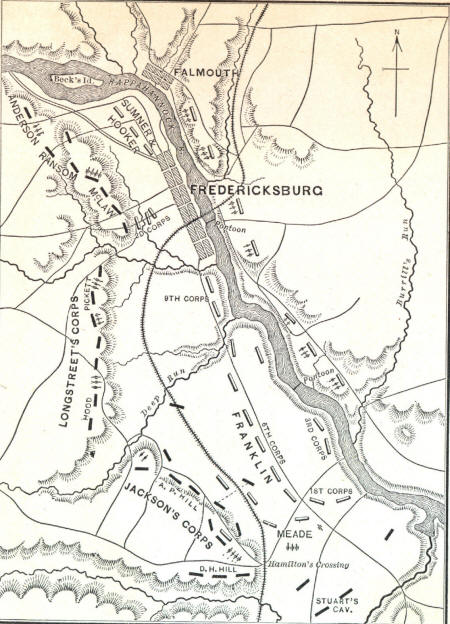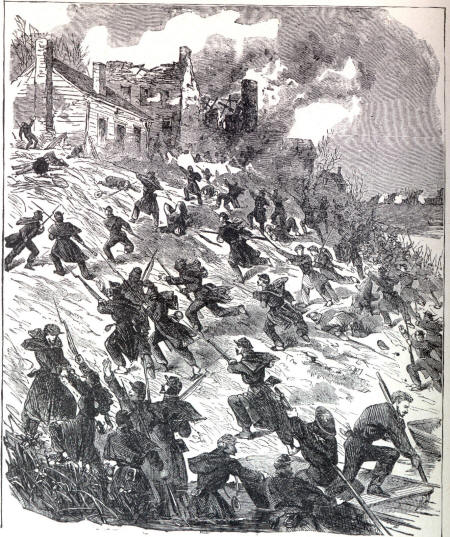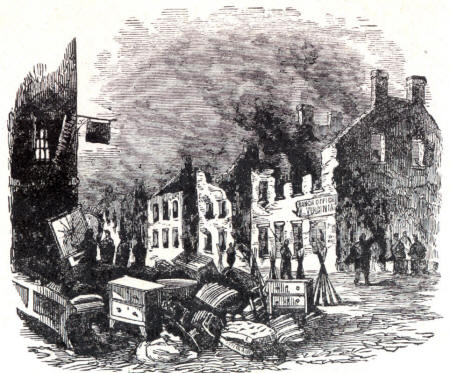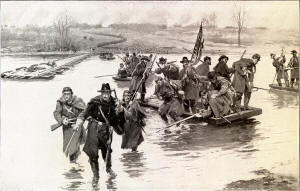|
On Oct. 6 the President instructed
McClellan to " cross the Potomac and give
battle to the enemy, or drive him South. Your army must now move," he said,
" while the roads are good." Twenty-four days were spent in correspondence
before the order was obeyed,
McClellan complaining of a lack of men and
supplies to make it prudent to move forward. At length, when October had
nearly passed by and Lee's army was thoroughly rested and reorganized, and
communications with Richmond were re-established, the
Army of the Potomac
began to cross the river (Oct. 26), 100,000 strong. The Nationals were led
on the east side of the Blue Ridge, but failed to strike the retreating
Confederates over the mountain in flank or to get ahead of them; and
Lee
pushed Longstreet's troops over the Blue Ridge to Culpeper Courthouse,
between the Army of the Potomac and Richmond, ready to dispute the advance
of the Nationals. Quick and energetic movements were now necessary to sever
and defeat, in detail, Lee's army.

Battle Map- The Battle of Fredericksburg
On Nov. 5
MeClellan was relieved of command, and
General Burnside was put in his
place. A sense of responsibility made the latter commander exceedingly
cautious. Before he moved he endeavored to get his 120,000 men well in hand. Aquia Creek was made his base of supplies, and he moved the army towards
Fredericksburg on Nov. 10. Sumner led the movement down the left bank of the
Rappahannock. By the 20th a greater portion of Burnside's forces were
opposite Fredericksburg, and their
cannon commanded the town. Sumner
demanded the surrender of the city (Nov. 21). It was refused. The bridges
had been destroyed. A greater portion of the inhabitants now fled, and the
town was occupied by Confederate troops. Lee's army, 80,000 strong, was upon
and near the Heights of Fredericksburg by the close of November, and had
planted strong batteries there. The army lay in a semicircle around
Fredericksburg, each wing resting upon the Rappahannock, its right at
Port
Royal and its left 6 miles above the city. Pontoons for the construction of
bridges across the Rappahannock were not received by Burnside until the
first week in December. Then 60,000 National troops under Sumner and
Hooker
lay in front of Fredericksburg, with 150 cannon, commanded by
General Hunt.
The corps of Franklin, about 40,000 strong, was encamped about 2 miles
below.

The
Attack on Fredericksburg
On the morning of Dec. 11 the engineers went quietly to work to construct
five pontoon bridges for the passage of the National army. Sharpshooters
assailed the engineers. The heavy ordnance of the Nationals on Stafford
Heights opened upon the town, set it on fire, and drove out many troops. The
sharpshooters remained. They were dislodged by a party that crossed the
river in boats, the bridges were rebuilt, and by the evening of the 12th a
greater portion of the National army occupied Fredericksburg, and on the
morning of the 13th made a simultaneous assault all along the line. The
Confederates, with 300 cannon, were well posted on the heights and ready for
action. The battle was begun by a part of Franklin's corps, Meade's
division, supported by Gibbon's, with
Doubleday's in reserve.
Meade soon
silenced a Confederate battery, but very soon a terrible storm of shells and
canister-shot, at near range, fell upon him. He pressed on, and three of the
assailing batteries were withdrawn. Jackson's advance line, under
A. P.
Hill, was driven back, and 200 men made prisoners, with several battleflags
as trophies. Meade still pressed on, when a fierce assault by Early
compelled him to fall back. Gibbon, who came up, was repulsed, and the
shattered forces fled in confusion; but the pursuers were checked by General
Birney's division of
Stoneman's corps.

SCENE IN FREDERICKSBURG ON THE MORNING OF
DEC. 12, 1862. The Nationals could
not advance, for Stuart's cavalry, on
Lee's right strongly menaced the Union
left. Finally, Reynolds, with reinforcements, pushed back the Confederate
right to the Massaponax, where the contest continued until dark. Meanwhile,
Couch's corps had occupied the city, with Wilcox's between his and
Franklin's. At noon Couch attacked the Confederate front with great vigor.
Kimball's brigade, of French's division, led,
Hancock's following.
Longstreet was posted on Marye's Hill, just back of the town. Upon his
troops the Nationals fell heavily, while missiles from the Confederate
cannon made great lanes through their ranks. After a brief struggle, French
was thrown back, shattered and broken, nearly one-half of his command
disabled. Hancock advanced, and his brigades fought most vigorously. In
fifteen minutes, Hancock, also, was driven back. Of 5,000 veterans whom he
led into action, 2,013 had fallen.
Howard's
division came to the aid of French and Hancock; so, also, did those of
Sturgis and Getty. Finally, Hooker crossed the river with three divisions.
He was so satisfied with the hopelessness of any further attacks upon the
strong position of the Confederates, that he begged Burnside to desist. He
would not yield. Hooker sent 4,000 men in the track of French, Hancock, and
Howard, to attack with bayonets only. These were hurled back by terrific
volleys of rifle-balls, leaving 1,700 of their number prostrate on the
field. Night soon closed the awful conflict, when the Army of the Potomac
had 15,000 less of effective men than it had the day before.
Burnside,
intent on achieving a victory, proposed to send his old corps, the 9th,
against the fatal barrier (a stone wall) on Marye's Hill, but Sumner
dissuaded him, and, on the 14th and 15th, his troops were withdrawn to the
north side of the Rappahannock, with all his guns, taking up his pontoon
bridges. Then the Confederates reoccupied Fredericksburg.
|



